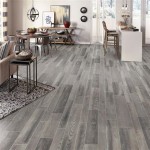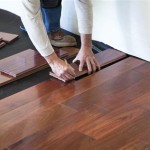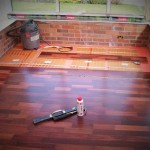Removing Paint From Hardwood Floors Without Sanding
Hardwood floors are a desirable feature in many homes, adding warmth, character, and value. However, these floors are sometimes covered with paint, either intentionally or as a result of spills and accidents over time. While sanding is a common method for removing paint from hardwood floors, it can be labor-intensive, create dust, and potentially damage the wood if not done carefully. Fortunately, several alternative methods exist for removing paint without resorting to sanding. These techniques often involve chemical strippers, heat guns, or specialized tools, each with its own advantages and disadvantages. Choosing the appropriate method depends on the type of paint, the condition of the floor, and the desired outcome.
Before undertaking any paint removal project, it is crucial to identify the type of paint involved. Oil-based and latex paints require different approaches. Oil-based paints are generally more resistant to removal and may necessitate stronger chemical strippers. Latex paints, being water-based, are often easier to remove. Testing a small, inconspicuous area of the floor is recommended to determine the paint type and assess the effectiveness of the chosen removal method. This precautionary step can prevent damage to the flooring and ensure a successful outcome.
Safety is paramount when working with any paint removal technique, especially those involving chemicals or heat. Adequate ventilation is essential to prevent the inhalation of harmful fumes. Protective gear, including gloves, eye protection, and a respirator, should be worn at all times. Children and pets should be kept away from the work area to avoid accidental exposure to hazardous materials. Disposing of paint scrapings and used materials responsibly is also crucial, in accordance with local regulations.
Choosing the Right Chemical Stripper
Chemical strippers are a common method for removing paint from hardwood floors without sanding. These products work by softening the paint, allowing it to be scraped or lifted from the surface. However, it is vital to select a stripper that is compatible with hardwood and appropriate for the type of paint being removed. Consider the following factors when choosing a chemical stripper:
Type of Stripper: Chemical strippers are available in various formulations, including solvent-based, water-based, and citrus-based options. Solvent-based strippers are typically the most effective for removing multiple layers of paint or stubborn oil-based paints. However, they also tend to be the most toxic and require careful handling. Water-based and citrus-based strippers are generally considered safer and less odorous, but they may be less effective on certain types of paint. Citrus-based strippers are favored for their biodegradable nature and pleasant scent, making them a more environmentally friendly option. Carefully read the product label and safety data sheet (SDS) to understand the ingredients, potential hazards, and proper usage instructions.
Dwell Time: Dwell time refers to the amount of time the stripper needs to remain on the surface to effectively soften the paint. This time can vary depending on the product and the thickness of the paint. Following the manufacturer's instructions regarding dwell time is crucial for achieving optimal results. Applying the stripper too thinly or not allowing it to dwell for the recommended period may result in incomplete paint removal. Conversely, leaving the stripper on for too long can potentially damage the wood. Regularly check the stripper's consistency and the softening of the paint during the dwell time to ensure it is working effectively.
Neutralization: After scraping off the softened paint, it is essential to neutralize the stripper residue. Neutralization helps to prevent the stripper from continuing to react with the wood, which can cause discoloration or damage. The neutralization process typically involves washing the floor with a specific neutralizing agent or a mixture of water and vinegar. The product label will specify the appropriate neutralizing agent and procedure. Thoroughly rinsing the floor after neutralization is also necessary to remove any remaining residue.
Applying the chemical stripper requires careful attention. Begin by applying a thick, even layer of stripper to the painted area, following the manufacturer's instructions. Allow the stripper to dwell for the recommended time, monitoring its progress. Once the paint has softened, use a plastic scraper to carefully remove it. Avoid using metal scrapers, as they can scratch the hardwood. Work in small sections and dispose of the paint scrapings properly. After removing the paint, neutralize the floor and rinse thoroughly as instructed by the stripper manufacturer. Allow the floor to dry completely before applying any finish.
Utilizing a Heat Gun for Paint Removal
A heat gun can also be used to remove paint from hardwood floors without sanding. Heat guns soften the paint, making it easier to scrape away. However, caution is necessary, as excessive heat can scorch or damage the wood. This method is best suited for small areas or for removing loose paint flakes.
Heat Gun Technique: When using a heat gun, hold it a few inches away from the painted surface and move it slowly and steadily. Avoid focusing the heat on one area for too long, as this can cause the paint to bubble or burn. As the paint softens, use a plastic scraper to gently remove it. Work in small sections and overlap your passes with the heat gun to ensure even heating. Keep a close eye on the wood to prevent overheating. If the wood starts to darken or smoke, immediately move the heat gun away.
Ventilation and Safety: Proper ventilation is crucial when using a heat gun, as heating the paint can release harmful fumes. Open windows and doors to create airflow, and wear a respirator to protect your lungs. Be mindful of the surrounding environment and ensure there are no flammable materials nearby. Also be aware of potential fire hazards. Have a fire extinguisher readily available in case of emergencies.
Potential Risks: While heat guns can be effective for removing paint, they also pose potential risks. Overheating the wood can cause it to warp, crack, or discolor. The heat can also damage the underlying finish or adhesive. Practice on an inconspicuous area before tackling the entire floor to assess the effect of the heat on the wood. If you notice any signs of damage, discontinue using the heat gun and consider an alternative method.
After removing the paint with a heat gun and scraper, clean the floor with a suitable cleaner to remove any remaining residue. Allow the floor to dry completely before applying any finish. Consider using a wood conditioner or primer to prepare the surface for finishing.
Employing Specialized Tools for Paint Removal
In addition to chemical strippers and heat guns, several specialized tools are available for removing paint from hardwood floors without sanding. These tools are designed to gently lift or scrape away the paint without damaging the wood. Some options include:
Paint Scrapers: Paint scrapers come in various shapes and sizes, with different blade types. Choose a scraper with a sharp, flexible blade that is suitable for hardwood floors. Scrapers with ergonomic handles can make the job more comfortable. When using a paint scraper, hold the blade at a low angle and apply gentle, even pressure. Avoid using excessive force, as this can damage the wood. Work in the direction of the wood grain to minimize the risk of scratching.
Multi-Tools with Sanding Pads: Oscillating multi-tools can be equipped with specialized sanding pads designed for gentle paint removal. These pads are less abrasive than traditional sandpaper and can be used to carefully remove paint without damaging the wood. Start with a fine-grit pad and gradually increase the grit as needed. Keep the multi-tool moving to prevent overheating the wood. Regularly inspect the sanding pad for wear and replace it as needed.
Detail Sanders: Detail sanders are small, handheld sanders that are designed for working in tight spaces and on intricate surfaces. These sanders can be equipped with fine-grit sanding pads or specialized paint removal pads. Use a light touch and keep the sander moving to prevent damaging the wood. Regularly clean the sanding pad to prevent clogging and ensure optimal performance.
When using any specialized tool for paint removal, follow the manufacturer's instructions carefully. Practice on an inconspicuous area before tackling the entire floor to get a feel for the tool and its effect on the wood. Wear appropriate safety gear, including eye protection and a dust mask. After removing the paint, clean the floor thoroughly and allow it to dry completely before applying any finish.
Regardless of the chosen paint removal method, patience and careful technique are essential for achieving a successful outcome. Avoid rushing the process or using excessive force, as this can damage the hardwood floor. Working in small sections and taking frequent breaks can help prevent fatigue and ensure accuracy. Remember to always prioritize safety and follow the manufacturer's instructions for any products or tools used. With the right approach, it is possible to remove paint from hardwood floors without sanding and restore their natural beauty.

Tested 10 Easy Ways To Get Paint Off Hardwood Floors Torera George

Easily Remove Paint From Your Floors

Paint Whitewash Hardwood Floors Without Sanding

Does Wd 40 Remove Paint From Hardwood Floors Mr Sander

Easily Remove Paint From Your Floors

Does Sanding Floors Remove Paint Mr Sander

How To Remove Paint Off Hardwood Floors Safely

How To Remove Paint From Wood The Home Depot

How To Remove Paint From Wood Finishes Direct

Does Wd 40 Remove Paint From Hardwood Floors Mr Sander
Related Posts








